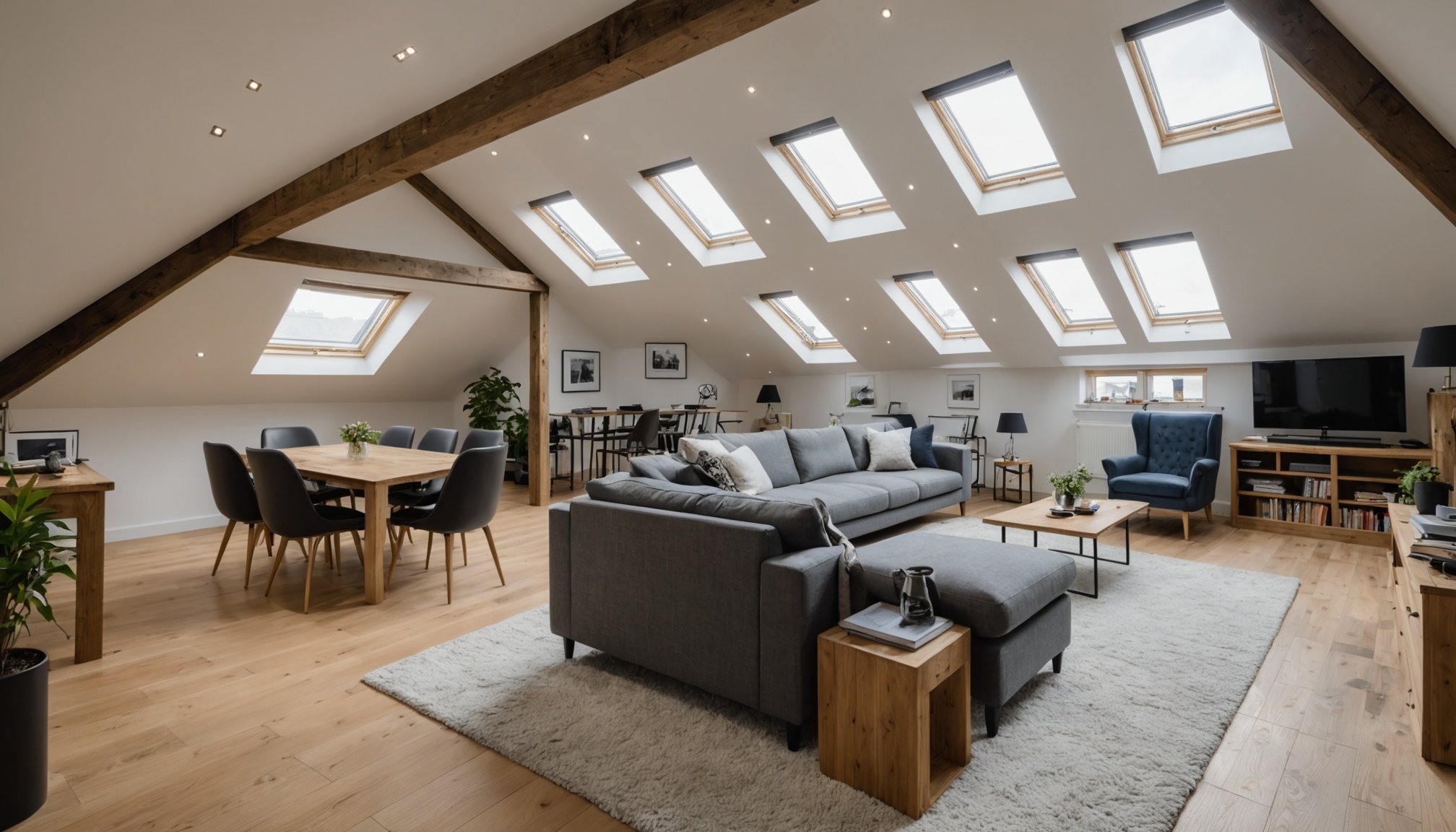Overview of Loft Conversions in Manchester
A Manchester loft conversion transforms unused attic space into functional and aesthetically pleasing areas. This transformation enhances both the home’s space and value, catering to growing families or those seeking additional storage. Often, a loft conversion can provide much-needed home office, bedroom, or playroom space, without the expense or hassle of moving. In Manchester, with its unique architectural styles, these conversions have become increasingly popular.
Manchester’s urban landscape, a blend of traditional and modern properties, makes it a prime location for such projects. Homeowners here often face choices between increasing living space or relocating. Opting for a loft conversion minimizes stress, retaining the familiar environment while granting added functionality.
Lire également : Unlocking Property Value Growth: A Guide to Monitoring Appreciation in Manchester”s Gentrifying Neighborhoods
Understanding the legal requirements and navigating the planning regulations is crucial before starting. These regulations ensure safety and compliance with the building standards. Not every loft conversion will require planning permission, although adherence to certain regulations is necessary. Factors influencing this include property type, existing alterations, and proximity to boundaries.
Before diving into this home improvement, consulting a specialist in Manchester can guide the design and ensure all legal criteria are met. Such preparation can save time, prevent complications, and ensure a seamless transformation process.
A lire également : How Upcoming City Planning Initiatives Will Transform Real Estate in Cardiff
Planning Permissions for Loft Conversions
Navigating the world of planning permissions can be a puzzling journey for homeowners eager to embrace the expansion possibilities offered by loft conversions. Understanding when these permissions are necessary is pivotal. Generally, your conversion may fall under permitted development rights, and therefore not require full planning permission. However, this isn’t always straightforward. For instance, if your conversion includes altering the roof space beyond its current dimensions, such as adding a dormer or extending beyond the original structure, you’ll likely need permission from your local planning authority.
Permitted development rights can significantly simplify the process, assuming your project doesn’t surpass specific limits and conditions, like height or volume restrictions. Nevertheless, these rights are not universal; listed buildings or homes within conservation areas may not benefit from these allowances and will almost always require a formal application.
Key considerations when submitting a planning application include providing detailed drawings and specifications of the proposed work. Ensuring compliance with building regulations and assessing potential impacts on neighbours is equally crucial. By meticulously considering the planning permissions and leveraging permitted development rights where applicable, homeowners can beautifully transform their lofts without unnecessary bureaucratic hurdles.
Building Regulations Compliance
When considering a loft conversion, understanding building regulations is crucial. These regulations ensure a safe and structurally sound conversion, maintaining integrity within your home. Notably, building regulations differ from planning permissions, the latter governing external changes to a property. Instead, building regulations focus on safety aspects such as structural integrity, insulation, ventilation, and fire safety.
To achieve compliance, structural integrity is paramount. This involves ensuring load-bearing walls and floors are adequately strengthened to support additional weight. Incorporating safety standards like proper insulation and effective ventilation leads to a safer, more habitable space.
Compliance isn’t just about following safety protocols; it’s also a legal requirement. When a loft conversion is completed, certification is needed to prove adherence to building regulations. This involves submitting detailed architectural plans and specifications. An inspector from the local council typically reviews these documents and inspects the work at various stages.
It’s helpful to hire a professional experienced in loft conversions, as they can navigate the complex landscape of these regulations for you. Ensuring compliance not only safeguards your property but also prevents potential legal issues in the future. Ultimately, adhering to building regulations elevates the quality and safety of your loft conversion project.
Necessary Permits and Approvals
When considering a loft conversion in Manchester, understanding the necessary permits and approvals is crucial. Generally, there are two main types of permits required: planning permission and building regulations approval. Whether these are needed depends significantly on the nature and scope of your project.
Planning permission may not always be necessary, especially if the conversion meets certain criteria like being under specified size limitations or not altering the roof’s structure. However, it’s essential to check with the local authority as there may be unique stipulations for your area. In contrast, building regulations approval is almost always required to ensure that the conversion is safe and compliant with structural, fire safety, and energy efficiency standards.
To obtain the necessary approvals from the local authority, start by submitting detailed plans and specifications. This process might involve assessments or modifications to your proposal in response to feedback from building officers. Anticipate some common delays, such as revisions for structural safety concerns or compliance with aesthetic requirements unique to certain neighbourhoods. By preparing thoroughly and understanding the local authority’s requirements, homeowners can navigate these challenges more smoothly.
Health and Safety Regulations
Delving into health and safety within construction, it’s crucial to understand the extensive safety codes and practices designed to protect everyone involved. When planning any project, like a loft conversion, the first step is a thorough risk assessment. But what does that entail?
A risk assessment is an essential process where potential hazards are identified, analysed, and evaluated. Identifying hazards involves spotting anything that might cause harm within the construction environment. Evaluating these risks then helps in determining who might be harmed and how such incidents can be prevented.
Safety codes serve as guiding principles for maintaining secure working conditions. For loft conversions, these codes include ensuring structural integrity and maintaining fire safety protocols, such as adequate escape routes. Compliance with safety codes not only protects construction workers but also safeguards future occupants.
To ensure high health and safety standards, it’s vital to regularly inspect tools and equipment, provide adequate training, and foster a culture of safety on-site. By prioritising risk assessment and adhering to safety codes, you create an environment where potential dangers are minimised, allowing construction to proceed securely and efficiently.
Navigating Common Pitfalls
Embarking on a loft conversion can be an exciting, yet daunting task. Homeowners often face common pitfalls that can lead to significant delays and unexpected costs. One of the most frequent issues involves legal complications. Without proper research and understanding, homeowners might overlook necessary permits or violate zoning laws. To avoid these legal issues, it’s crucial to consult with local authorities to understand regulations and secure all required approvals.
Another common mistake is neglecting to consult with construction experts. Professional insight is invaluable for identifying potential structural issues early, which can prevent costly mistakes later. Homeowners should ensure that they hire reputable contractors who are familiar with local building codes and standards.
To mitigate these pitfalls, careful planning and adequate research are essential. Here are a few strategies to help ensure a smooth project trajectory:
- Engage with legal advisors to understand any zoning restrictions or legal obligations in your area.
- Employ a qualified architect or engineer to assess structural requirements.
- Obtain multiple quotes before hiring to ensure a fair price and avoid potential scams.
By proactively addressing potential pitfalls, homeowners can ensure their loft conversion not only enhances their living space but adds value to their property without unnecessary legal headaches.
Timelines and Costs Involved
Embarking on a loft conversion is an exciting project but requires careful planning to align with project timelines and project costs. Understanding these elements ensures a smooth process.
An important first step is obtaining the necessary permits. Typically, securing these permits can take between 4 to 8 weeks. This timeline can vary based on location and local authority. Once permits are in hand, the conversion itself usually spans 6 to 12 weeks, depending on the project’s complexity.
Project costs can also fluctuate widely. Key factors influencing these costs include the size of your loft, desired design, and structural changes needed. Generally, basic loft conversions can start around £20,000, but high-end renovations may exceed £60,000.
Budgeting effectively is crucial. Consider dividing the budget into:
- Permits and planning fees
- Construction and materials
- Interior design and finishes
To manage both project timelines and costs efficiently, consider these tips:
- Plan Ahead: Begin permit processes early to avoid delays.
- Obtain Multiple Quotes: Comparing quotes can prevent overspending.
- Build in a Contingency Fund: Allocate 10-15% for unexpected expenses.
By staying informed and organized, you can ensure your loft conversion stays on track and within budget.
Resources for Homeowners
Homeowners in Manchester have access to a variety of resources designed to offer valuable support. Recognizing the importance of these tools is essential for making well-informed decisions about home management and maintenance.
Local authority websites serve as a significant hub of information. They provide homeowner guides that cover a wide range of topics, from property taxes to renovation permits. These sites often feature updates on local regulations that may impact homeowners, making it a crucial starting point for acquiring relevant knowledge.
It is advisable to take advantage of guidance documents that can be found online. These documents frequently offer detailed insights into best practices for maintaining a home, as well as step-by-step guides on how to tackle common issues like plumbing repairs or energy efficiency improvements.
When navigating these resources, the importance of seeking professional advice cannot be overlooked. Professionals in the field, such as real estate experts and certified contractors, offer invaluable insights that are tailored to the specific needs of your property.
- Consult local contractors for maintenance advice.
- Seek out real estate professionals for market insights.
- Access legal experts for property law consultation.
By utilizing these support systems, homeowners can confidently address their concerns, ensuring their homes are well-managed and in compliance with local standards.











